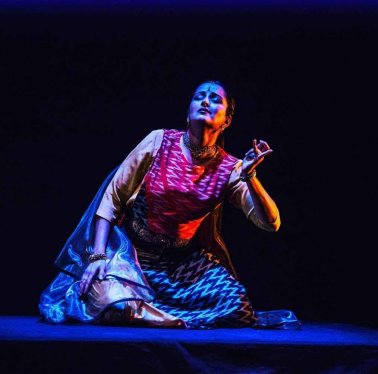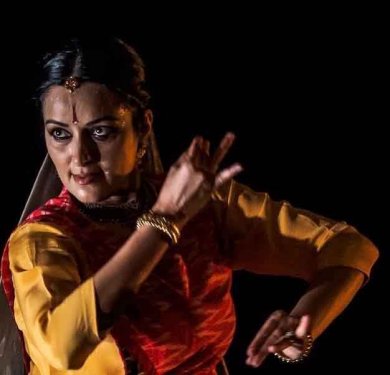
|   |

|   |
Still I Rise: A bold, thought provoking production - Priya Das e-mail: priyafeatures@gmail.com June 8, 2018 San Francisco Bay Area experienced the world premiere of Still I Rise, a solo performance by Vidhya Subramanian on May 18, 2018, in Palo Alto, California. (Presented by Narika, an organization for women's empowerment). While all elements of the production are noteworthy, this review will only speak to the dance aspects. Subramanian's latest production is a fabric woven from seven threads, each alluding to a nuance of fire while portraying known and imagined episodes in Draupadi's tale. It begins with "Ashes," which has Vidhya center stage under a diaphanous material, in a yogic child's pose, performing sinewy movements. When she sits up, we realize that she's lamenting the loss of her sons, who have died a fiery death. In a hard-hitting Hindi passage, she seeks and speaks of their life together, never to be enjoyed any more. One saw Draupadi as a crushed mother for the first time perhaps; and then swiftly, she turns into an enraged contrast when she challenges Yudhishtra to secure revenge. Subramanian's capacity to handle such sorrow on stage and the ability to depict it elegantly, and then instantly turning into a fiery character were a lesson in artful body language, controlled facial expression, and more importantly, how to bring it all together to a single word, when she arises and calls out "Yudhishtra!" Vidhya then proceeded to release all that painful fury in flashes of abhinaya, such as when she showed the jewel being wrenched out from Ashwatthama's forehead and when she showed her own strong-but-trapped breath.   Photos: Swagato Basumallick "Luminance" shed a light in Tamizh, on Draupadi's presence in the universal kundalini; her place in all our lives as the sixth sense. There was an additional, interesting contrast. Luminance also shone a questioning light in the dark world inhabited by Gandhari. The program brought to centerstage the question: Why did Gandhari turn a blind eye that fateful day in court? Subramanian distils a spectrum of bhava into an impactful, contained explosion of expression in each line. Her portrayal of Draupadi is startlingly honest, as one bereaved mother to another, posing questions with no answers forthcoming. "Kindling" was aptly named: Draupadi's insult of Karna was one of the many episodes that led to the war. Subramanian was the excited Bengali Draupadi on the day of her Swayamvara, she was the embarrassed suitor, she was the hapless onlooker to the confrontation between her brother and Karna. Then she was the heroine who, in a single moment, is caught up in a lifetime of conflict. At one point, allows her young heroine to express joy, which was surprising given the weight of the situation. It speaks to the intimacy the artist must have felt with her nayika. Then, she ages instantaneously, as she realizes the import of her words. Subramanian's master stroke here was to depict her heroine marshalling her own sixth sense as she foresees the unfolding of terrible events. She then chose to youthfully shrug off the calamitous foreboding to have a petulant conversation with Krishna, which was memorable, as were the deliberate Odissi-like punctuations in the dancing here. "Combustion" was where Subramanian truly raised the bar on several fronts. Artistically speaking, through a simple coiling of fabric on upstretched legs while on a shoulder stand, she dared the world to look away from rape. Intellectually speaking, she contended that while Krishna may have saved Draupadi with a limitless saree, it is the very same saree that binds a woman, even at times to a misplaced and unjust sense of shame. Subramanian was the Draupadi embodied in each victim in a numb state of disbelief, the jury in a suspended state of verdict, and the deliberate reporter in a state of unrelenting questioning in Subramanya Bharathi's poem. It was uncomfortable, but at once the audience understood that this discomfort paled to that of any victim of plunder. Kudos to Subramanian for throwing a Truth and Dare challenge to the audience, not many artists do this. "Carnage" was also an act where Subramanian did one better than the other acts, since she was the victim that exacted her own revenge. Was she even Draupadi here? Aided and abetted by the well-known Kumara Vyasa Kannada poem, Subramanian's portrayal was stark in its manic thirst for revenge and flagrant (but elegant) in its enjoyment of it. The thin lines between artistic liberty, drama, Bharatanatyam, and the narrative were tightly aligned. The dancing was strong, evoking a catharsis while also showing the complete understanding between Bheema and Draupadi that transcended the physical plane. Whereas the typical depiction of this poem is one of uni-dimensional anger, Subramanian packed her bhava with layers upon layers of nuances.  "Incandescence" is literally a reflection of sisterhoods between the ages, where Draupadi, Radha, and Sita meet for a girls' night out. Subramanian delivered this via spoken words in English, and the act came as a delightful reprieve from the intensity of the past acts. At the heart of it was the question, why are Sita and Radha gifted with glory while Draupadi, who was bid and did as she was bid, is often misunderstood? Subramanian's rendition of this was superlative and built a bond between the audience and Draupadi, who was freed from her mythological anvil and placed among us, as our friend, sister, or mother. That the artist could become whole after carnage and then render humor was a major feat. "Uprising" has Draupadi (or is it our own sense of self?) looking at the current world and urging every woman to stand up for herself through the Pushyamitra Upadhyay's Hindi poem and Maya Angelou's poem Still I Rise. Powerfully delivered through dance and spoken word, it was decidedly rousing. At the end, Vidhya beckoned to the audience and several women joined her on stage, thus closing the circuit between stage and house; character and person; dancer and audience, mythology and reality. Overall, there needs to be more English words for the benefit of the audience that's already grappling with a change in episode and interpretation. However, Subramanian's angika abhinaya is clear and compelling; one is always in sync with at least the sentiment. The costume was understated and aligned with the theme: yellow, red, black, the colors of fire. Perhaps the orientation of the pattern could have been vertical instead of horizontal though. Subramanian is known to be partial to women-oriented topics; it can be said that her earlier experimentations with a nayika's characterization in a varnam, padam, javali, or ashtapadi were all leading up to this debut. There is a bold, minimalist, impactful, and more importantly, a resolute stirring of the plot, the dancing, and the format in Still I Rise. Priya Das is a writer based in San Francisco Bay Area, USA, covering extraordinary nuances of everyday life with a focus on the performing arts. She is a regular contributor to India Currents. Some of her writing is at priyafeatures.com |